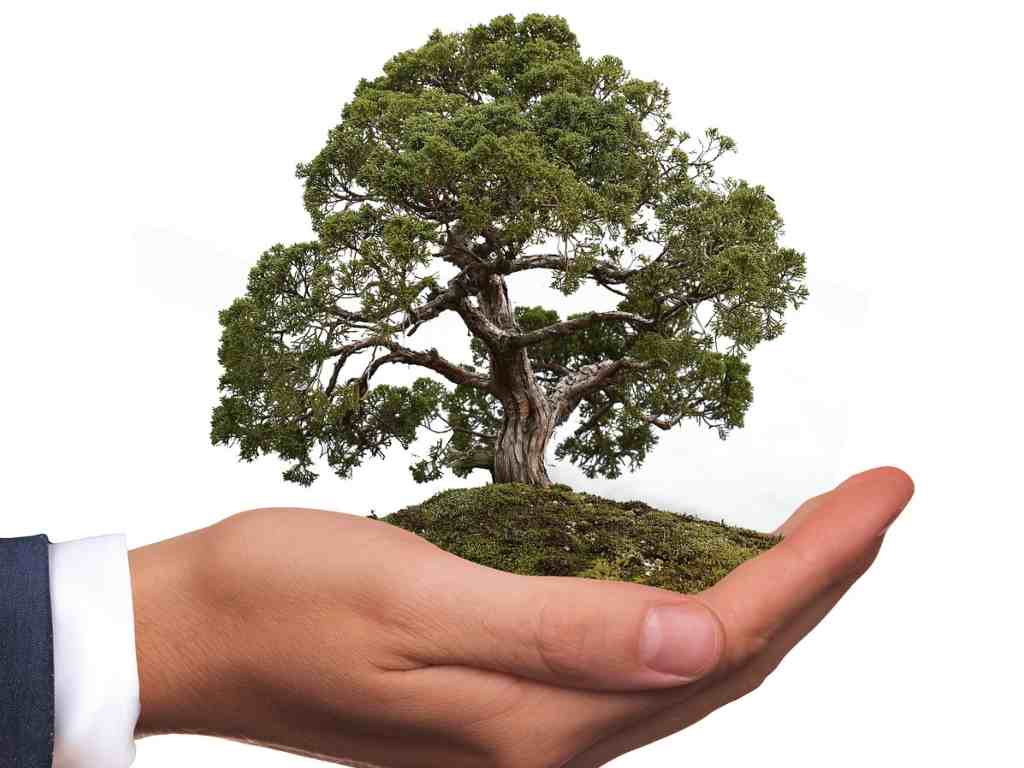Bonsai trees are a great addition to any home or office. They are not only beautiful, but they are also an excellent way to bring a little bit of nature indoors.
However, caring for a bonsai tree can be a bit tricky, especially if you are new to the art of bonsai.
In this article, we will provide you with tips and tricks for keeping your bonsai tree healthy and thriving.
This comprehensive guide will cover everything from choosing the right type of tree to pruning and shaping your bonsai, to watering and fertilizing it, to troubleshooting common problems and diseases.
So, let’s get started…
9 Care Tips For Bonsai
1. Selecting the Right Bonsai Tree
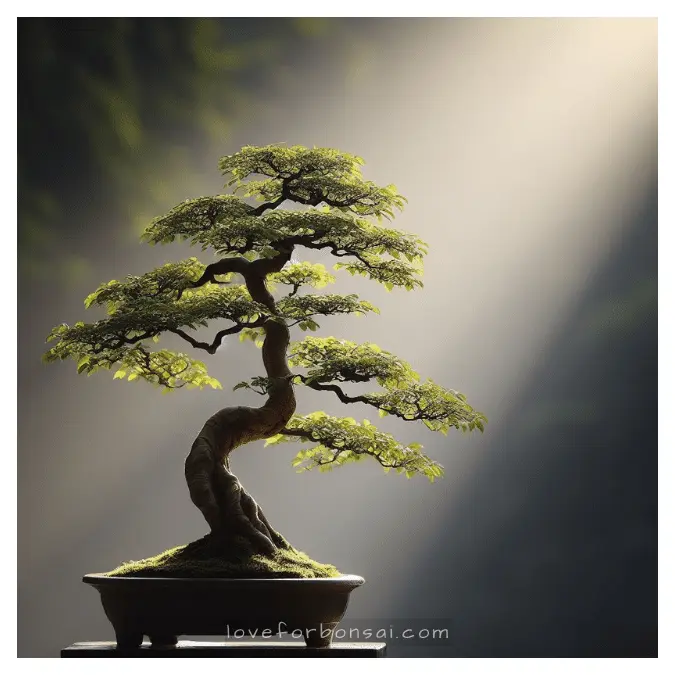
Choosing the right bonsai tree is crucial to its overall health and growth. Here are some factors to consider when selecting a bonsai tree:
Choosing the Right Species
Selecting the right bonsai tree species is essential for ensuring its longevity and health. Some popular bonsai species include juniper, pine, maple, and ficus.
As each species has its own unique requirements for care, including water, sunlight, and soil type. Before selecting a bonsai tree, research the species and its specific care needs to ensure you can provide the optimal environment for its growth.
Selecting the Right Size
Bonsai trees come in a variety of sizes, from small tabletop trees to larger trees that can stand on their own. When selecting the right size bonsai tree, it’s important to consider your available space, as well as the level of care required for the tree.
Smaller bonsai trees generally need more frequent watering and pruning, while larger trees may require less maintenance but more space to thrive.
Understanding the Age of the Tree
Bonsai trees come in a wide range of ages, from newly planted seedlings to trees that have been meticulously maintained for decades. The age of the tree plays a crucial role in determining its specific care requirements. As the tree matures, its care needs change, and older trees may need different pruning techniques or fertilizers than younger trees.
Additionally, transplanting older trees may be more challenging due to their well-established root systems. Therefore, it’s essential to understand the age of the bonsai tree to provide it with the appropriate care.
Inspecting the Tree
Finally, you must inspect it with great care and attention, as if you were choosing a beloved pet. Look for the telltale signs of health and vitality, such as vibrant green leaves and sturdy branches that can bear the weight of the tree’s majestic beauty.
Don’t settle for anything less than perfection – avoid any trees that show even the slightest hint of damage, disease, or infestation. A strong and healthy bonsai tree is a work of art, with a resilient trunk that will stand the test of time and bring you joy for years to come.
Choose your bonsai tree with love and care, and it will reward you with a lifetime of beauty and wonder.
2. Choosing the Right Pot and Soil for Your Bonsai Tree
Choosing the perfect pot and soil for your bonsai tree is a crucial step in its care routine. It’s like finding the perfect home for your beloved pet – it needs to be just the right fit.
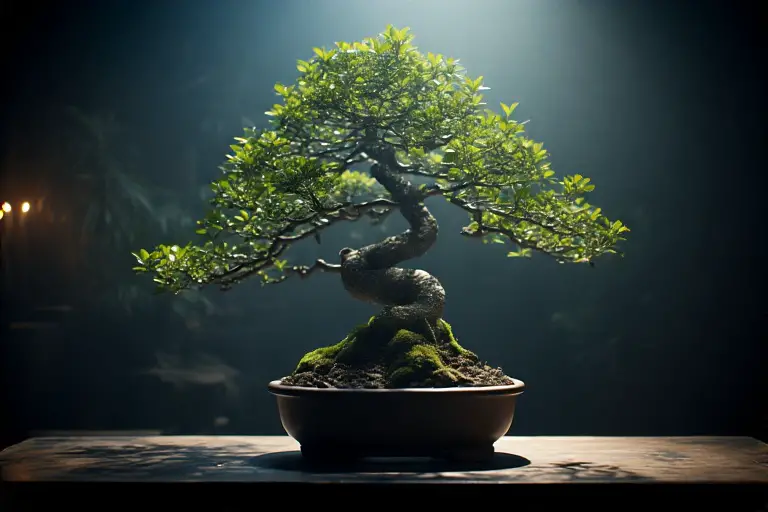
A bonsai tree needs soil that provides proper drainage and allows oxygen to reach its roots. The wrong type of soil can lead to root rot and other problems that can harm your tree’s health.
To ensure that your bonsai tree thrives, choose high-quality soil that is specifically formulated for bonsai trees. It is typically made up of a mix of ingredients such as perlite, peat moss, and sand, which provide the perfect balance of drainage and nutrient retention.
The pot you choose for your bonsai tree should be the right size for the tree’s roots, with enough room to grow but not so much that the tree becomes unstable.
It’s also important to choose a pot with adequate drainage holes to prevent water from accumulating and potentially drowning your tree’s roots.
You can get creative with your pot selection, too! Some bonsai enthusiasts opt for traditional ceramic pots, while others prefer more unique materials such as wood or even seashells.
Just make sure that your pot is suitable for your tree’s needs and fits in with the overall aesthetic you’re going for.
Ultimately, choosing the right pot and soil for your bonsai tree can make all the difference in its health and longevity. Take the time to research and find the best options for your bonsai tree.
3. Planting the Tree
Planting your bonsai tree is an incredibly exciting moment, as it represents the beginning of a new journey with your tiny living companion. Treat this moment with care and attention to ensure the best start for your bonsai tree.
Begin by placing a layer of soil at the bottom of the pot, ensuring there’s enough space for the roots to spread. Next, gently remove your bonsai tree from its current container, and carefully loosen any tangled roots with your fingers. Be sure not to damage the roots while removing them, as this can harm the tree’s health.
Place your bonsai tree into the new container and position it carefully, making sure it’s standing straight and stable. Fill the remaining space with your well-draining bonsai soil, taking care not to cover the tree’s base.
The soil should be level with the top of the pot, and firm enough to support the tree’s weight. Finally, water the tree thoroughly, ensuring the soil is fully saturated.
Remember, planting your bonsai tree is an important step in its care routine and sets the foundation for its future growth and development. Take your time and enjoy the process of creating a beautiful and healthy home for your bonsai tree.
4. Watering Your Bonsai Tree
Your bonsai tree needs love and attention, and watering it is a crucial part of its care. You want to keep your tree hydrated, but you also need to be careful not to overdo it. Think of it like a delicate dance between giving it enough water to thrive, but not so much that it drowns.
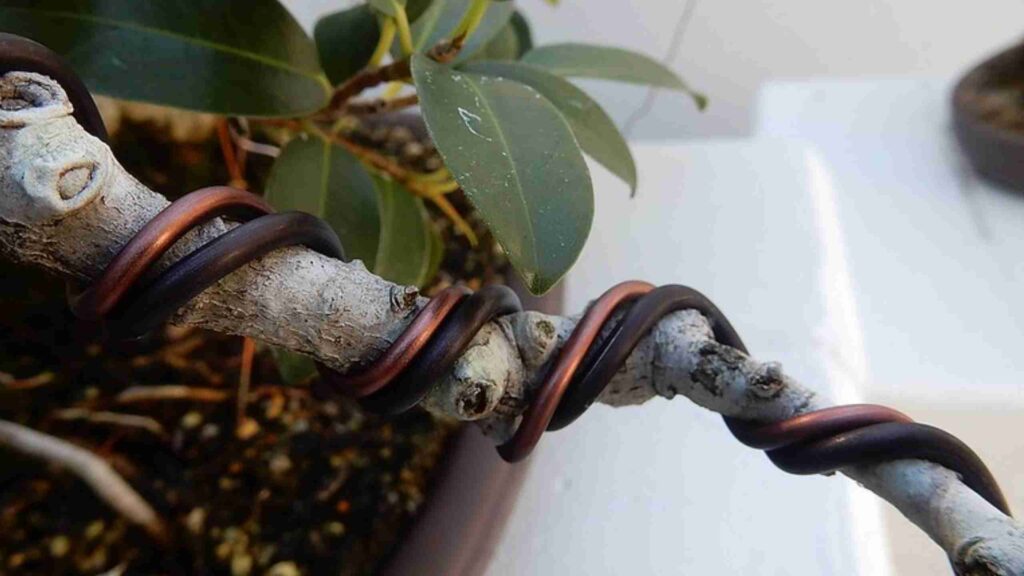
One way to check if your bonsai needs water is to stick your finger about an inch into the soil. If it feels dry, it’s time to water. But if it still feels moist, wait a day or two before checking again.
Keep in mind that different types of bonsai trees have different water needs. For example, a tropical bonsai will need more water than a desert bonsai.
Be sure to research the specific watering needs of your tree’s species and adjust accordingly.
Always use room temperature water – cold water can shock the roots and cause damage.
One trick to help prevent overwatering is to use a well-draining soil mix. This allows excess water to flow through the soil and out of the drainage holes in the pot, preventing the roots from becoming waterlogged. And remember, your bonsai tree is a living being, so pay attention to its signals.
If the leaves are turning yellow or dropping off, it may be a sign of overwatering. Conversely, if the leaves are wilting or turning brown, it may be a sign of underwatering.
With patience and a little bit of attention, you’ll be able to find the perfect balance for your bonsai tree’s watering needs.
5. Fertilizing Your Bonsai Tree
Just like a child needs proper nutrition, your bonsai tree also requires the right amount of nutrients to grow healthy and strong. Fertilizing your bonsai tree is an essential part of its care routine. It’s like feeding your child the right food to help them develop their physical and mental capacities.
Choosing the right fertilizer is crucial to ensure your bonsai tree gets the right amount of nutrients. You can use organic or synthetic fertilizers, but make sure to use a balanced fertilizer that contains all the necessary nutrients.
Over-fertilizing can do more harm than good, as it can burn the roots and damage the tree. Just like how you won’t overfeed your child, you also need to be careful not to over-fertilize your bonsai tree.
By providing your bonsai tree with the right amount of nutrients, you are helping it thrive and grow to its full potential. So, take the time to fertilize your bonsai tree regularly, and enjoy the satisfaction of seeing it flourish under your care.
6. Pruning Your Bonsai Tree
Taking care of your bonsai tree is a labor of love, and pruning is a crucial aspect of that care. When you prune your bonsai tree, you’re not only maintaining its shape and size but also encouraging healthy growth.
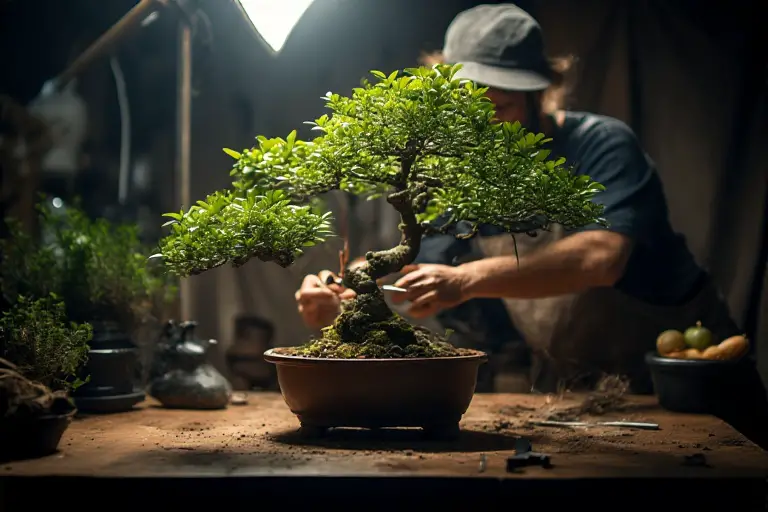
Regular pruning helps to remove any dead or dying branches, preventing the spread of disease and promoting new growth. It’s important to be patient and take your time when pruning, carefully selecting which branches to cut and which to keep.
Pruning is a form of art, and every cut you make will affect the overall look and health of your bonsai tree. But with a steady hand and a keen eye, you can transform your bonsai into a work of art.
7. Repotting Your Bonsai Tree
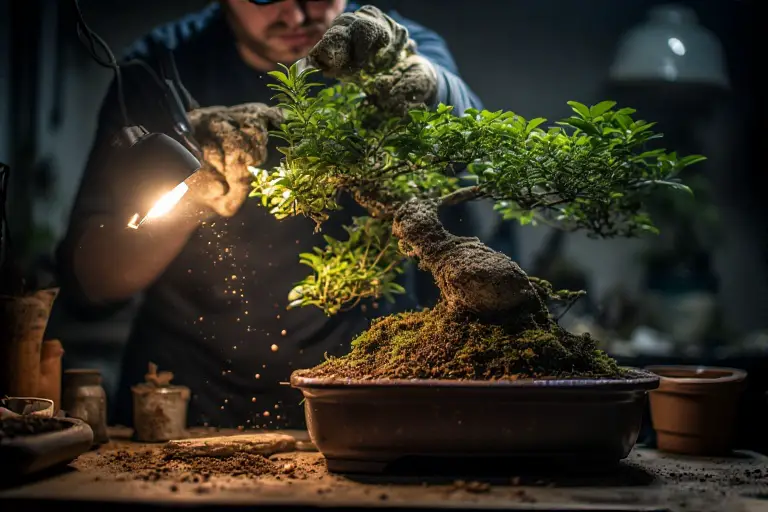
Repotting your beloved bonsai tree may seem like a daunting task, but it is an essential part of its care. Just like us, our bonsai trees need room to grow and thrive.
Over time, their roots will outgrow their pot, and repotting will become necessary to provide them with the space they need.
Choosing the right pot for your bonsai tree is crucial. The pot should be slightly larger than the previous one, but not too large, as this can cause the soil to retain too much moisture, leading to root rot.
Select a pot that complements the shape and style of your bonsai tree, and make sure it has adequate drainage holes to prevent water from pooling.
Before repotting, it’s important to inspect your bonsai tree for any signs of disease or damage. Remove any dead or diseased roots and trim back any long, straggly roots. This will promote healthy growth and prevent any issues from spreading.
Next, carefully remove your bonsai tree from its old pot and gently loosen any tangled roots. Add a layer of well-draining soil to the bottom of the new pot and place your bonsai tree in the center.
Fill in the remaining space with soil, taking care to press it down firmly around the roots.
After repotting, your bonsai tree may experience some shock as it adjusts to its new environment. It’s important to keep it out of direct sunlight and to water it sparingly for the first few weeks.
8. Protecting Your Bonsai Tree
As a bonsai enthusiast, there’s nothing more heartbreaking than seeing your beloved tree suffer from pests. These little creatures can wreak havoc on your tree’s health and stunt its growth. It’s crucial to keep a close eye on your bonsai and regularly inspect it for any signs of trouble.
When you see yellowing leaves or small holes in the leaves, it’s a sign that something is wrong. Don’t ignore it!
Take immediate action and tackle the problem before it gets worse. There are many treatments available, from natural remedies to commercial pesticides.
Choose the method you prefer and apply it with care. Remember, your bonsai tree is like a family member, and it’s your responsibility to protect it from harm.
9. Displaying Your Bonsai Tree
Your bonsai tree is not just a plant; it’s a work of art that deserves to be displayed in the best possible way. Choosing the perfect location to display your bonsai tree is key to its health and beauty.
Make sure to place your bonsai tree in a spot that receives plenty of natural light, but is not too exposed to harsh sunlight or extreme temperatures. Remember, your bonsai tree is a living creature, and it needs to be protected from the elements just like you do.
When it comes to choosing a display stand for your bonsai tree, don’t settle for just any old thing. Your bonsai tree deserves a stand that complements its beauty and enhances its overall appearance.
Whether you choose a traditional wooden stand, a sleek modern stand, or something in between, make sure that it brings out the best in your bonsai tree.
Displaying your bonsai tree is not just about showing it off to others. It’s also about enjoying it yourself. Sit back and appreciate the beauty and artistry of your bonsai tree, and let it bring a sense of peace and tranquility to your home or office.
Frequently asked questions (FAQs):
How often should I water my bonsai tree?
Watering your bonsai tree is essential to keep it healthy, but the frequency depends on several factors, including the size of the pot, the type of soil, and the environment.
As a general rule, you should water your bonsai tree when the soil feels slightly dry to the touch.
How do I know when to fertilize my bonsai tree?
As a rule of thumb, you should fertilize your bonsai tree during the growing season, which is usually from spring to fall. However, the specific timing and frequency depend on the type of fertilizer and your bonsai’s needs.
It’s essential to read the instructions on the fertilizer package and avoid over-fertilizing, which can harm your tree.
Do I need to prune my bonsai tree?
Yes, pruning is an essential aspect of caring for your bonsai tree. Regular pruning helps maintain its shape and promote healthy growth by removing dead or unhealthy branches and leaves. Additionally, pruning also encourages new growth and enhances the overall aesthetics of your tree.
How often should I repot my bonsai tree?
Bonsai trees require repotting every two to three years or when the roots start to outgrow the pot. Repotting is necessary to ensure healthy growth and avoid root-bound conditions, which can cause various problems. However, the frequency also depends on the type of tree and its growth rate.
What type of soil should I use for my bonsai tree?
You can use various soil mixes, such as akadama, pumice, and lava rock, depending on your tree’s needs and environmental conditions.
It’s best to avoid regular potting soil, which can retain too much moisture and cause root rot.
Can I use regular fertilizer for my bonsai tree?
No, regular fertilizer may not provide the right balance of nutrients required for your bonsai tree. Instead, use a balanced fertilizer specifically formulated for bonsai trees. The fertilizer package should provide instructions on the timing and frequency of application, which may vary depending on the brand and the tree’s needs.
Conclusion:
Congratulations! You’ve made it to the end of this article on caring for your bonsai tree. By now, you know that owning a bonsai tree is more than just a hobby; it’s a way of life.
Through the ups and downs, you’ll learn to care for your little tree with patience, love, and a bit of creativity.
But don’t stop here! There’s always more to learn about the art of bonsai. Explore more articles on this site to expand your knowledge and take your skills to the next level.
And if you found this article helpful, be sure to share it with your friends and family who may also be interested in caring for their own bonsai tree.
